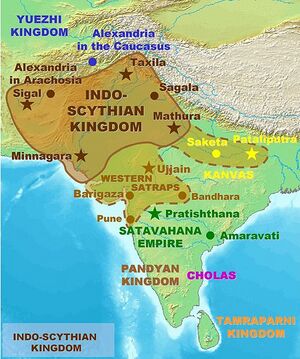Nahapana

Nahapana (r. 119–124 CE) (नहपान) was an important ruler of the Western Kshatrapas, descendant of the Indo-Scythians, in northwestern India. According to one of his coins, he was the son of Bhumaka.
History
The Kshatrapa dynasty became very powerful with the accession of Nahapana to the throne. Ksatrapa Bhumaka was succeeded by him who flourished about the period 60 CE. Jain Works are unanimous in that Nahapana ruled Ujjain for 40 years while the inscriptions made by Ushavadata evince that Nahapana ruled for 46 years. Thus, Nahapana must have captured Ujjain in his 6th regnal year. Periplus of 60 CE evince that Nahapana was ruling Ujjain, thus fixing his regnal period from around 119 CE to 124 CE. Nahapana managed however to build a strong power base in the west, occupying the traditional base of Satavahanas in Western Maharashtra.
He also established the Kshatrapa coinage, in a style derived from Indo-Greek coinage. The obverse of the coins consists of the profile of the ruler, within a legend in Greek. The reverse represents a thunderbolt and an arrow, within Brahmi and Kharoshthi legends.
Nahapana is mentioned as a donator in inscriptions of numerous Buddhist caves in northern India. The Nasik and Karle inscriptions refer to Nahapana's dynastic name (Kshaharata, for "Kshatrapa") but not to his ethnicity (Saka-Pahlava), which is known from other sources.[1]
Nahapana had a son-in-law named Ushavadata (Sanskrit: Rishabhadatta), whose inscriptions were incised in the Pandu-lena caves near Nasik. Ushavadata was son of Dinika and had married Dakshamitra, daughter of Nahapana.
According to the inscriptions, Ushavadata accomplished various charities and conquests on behalf of his father-in-law. He constructed rest-houses, gardens and tanks at Bharukachchha (Broach), Dashapura (Mandasor in Malva), Govardhana (near Nasik) and Shorparaga (Sopara in the Thana district). He also campaigned in the north under the orders of Nahapana to rescue the Uttamabhadras who had been attacked by the Malayas (Malavas). He excavated a cave (one of Pandavleni Caves) in the Trirashmi hill near Nasik and offered it to the Buddhist monks.[2]
Overstrikes of Nahapana's coins by the powerful Satavahana king Gautamiputra Satakarni have been found in a Southern Gujarat hoard at Jogalthambi. However, it is not necessary that Gautamiputra Satakarni and Nahapana to be contemporaries since Satakarni mentions that the areas he has conquered were ruled by Ushavadata, rather than Nahapana.
Mentioned in the Periplus
Nahapana is mentioned in the Periplus of the Erythraean Sea under the name Nambanus, as ruler of the area around Barigaza:
- “ Beyond the gulf of Baraca is that of Barygaza and the coast of the country of Ariaca, which is the beginning of the Kingdom of Nambanus and of all India. That part of it lying inland and adjoining Scythia is called Abiria, but the coast is called Syrastrene. It is a fertile country, yielding wheat and rice and sesame oil and clarified butter, cotton and the Indian cloths made therefrom, of the coarser sorts. Very many cattle are pastured there, and the men are of great stature and black in color. The metropolis of this country is Minnagara, from which much cotton cloth is brought down to Barygaza.” —Periplus 41[3]
ठाकुर देशराज लिखते हैं
ठाकुर देशराज लिखते हैं कि कनिष्क का राज्य-विस्तार उत्तर पश्चिमी भारत में विन्ध्याचल तक था। काश्मीर और सिंध को उसने अपने प्रारम्भिक समय में ही जीत लिया था। काश्मीर में उसके बनाए हुए बहुत से बौद्ध-मन्दिर और मठ हैं। उसकी राजधानी पुरुषपुर या पेशावर थी। उद्यान, गन्धार, तक्षशिला, सीतामढ़ी यह उनके राज्य के प्रसिद्ध शहर थे। कनिष्क ने चीनी तुर्किस्तान के काशगर, यारकन्द और खुतुन नामक प्रान्तों को जीतकर अपने राज्य में मिला लिया था। चीनी यात्री सुंगयुन ने पेशावर में बने हुए इसके बौद्ध-स्तूप और मठों की बड़ी प्रशंसा की। दन्तकथाओं से ऐसा मालूम होता है कि इसने पटना पर भी अधिकार कर लिया था। मि. स्मिथ कहते हैं कि महाराष्ट्र के शासक क्षहरात, नहपान और उज्जैन के शासक क्षत्रप चष्टन भी कनिष्क के अधीनस्थ सामन्त थे। कनिष्क के जो सिक्के मिले हैं, उनमें एक तरफ राजा का चित्र होता है। दूसरी तरफ स्त्री या शिवजी अथवा अन्य देवताओं के चित्रे रहते हैं। लेखों में कनिष्क की उपाधि ‘महाराज राजाधिराज देवपुत्र कनिष्क’ मिलती है।
इसके समय में शिल्पकला की अच्छी उन्नति हुई थी। इसके समय के बने हुए स्तूप मठ मूर्तियां इसकी साक्षी हैं। इसकी सभा में अनेक विद्वानों का जमघट रहता था।
जाट इतिहास:ठाकुर देशराज,पृष्ठान्त-205
आयुर्वेद का प्रसिद्ध ज्ञाता आचार्य चरक इनका राज्य-वैद्य था। नागार्जुन, अश्वघोष, वसुमित्र भी इसकी सभा में आते रहते थे।
External links
See also
- Chastana
- Indo-Scythians
- Indo-Scythian origin of the Jats
- Maues (c. 90-60 BCE)
- Minnagara
- Rudradaman I
- Rudrasena II
References
- ↑ History of the Andras
- ↑ Maharastra.gov.in Ancient Period
- ↑ Ancient History Sourcebook
Further reading
- R.C. Senior "Indo-Scythian coins and history" Vol IV, ISBN 0-9709268-6-3
Back to General History

